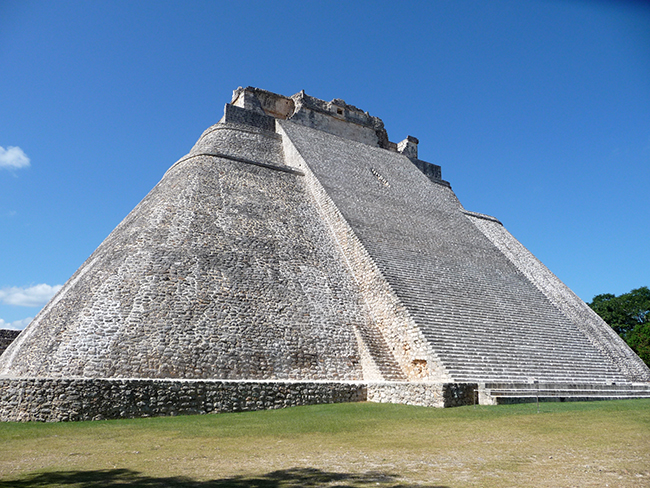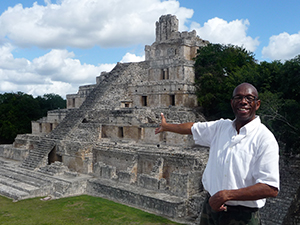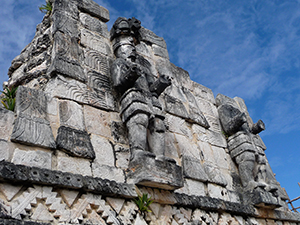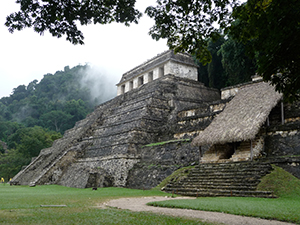Mexico’s Amazing Pyramids

By Jon Haggins
Photography by Laurel Van Horn
Mexico’s Yucatan has a rich Mayan history with numerous pyramids throughout the peninsula. Chichen Itza’s ancient Mayan pyramid, “Kukulcan” or “El Castillo,” (The Castle), as it is known in Spanish, became one of the Seven New Wonders of the World, and a UNESCO World Heritage Site in 2007.
El Castillo experiences an unusual phenomenon every year for two days during the spring equinox. A feathered serpent descends among mankind through the steps of the Chichen Itza Pyramid. It comes to bless the earth with fertility and prosperity, and its coming is witnessed by thousands of visitors who arrive at this famous Mayan structure. The construction is designed and located with such precise astronomical and engineering detail that the rays of sun lights up the steps, triangle by triangle, and finally rests on the stone head of the serpent deity at the base of the stairs. It is one of the most spectacular phenomena in the entire world.

Chichen Itza’s Pyramid is a classic representation of the Mayan civilization that thrived in the Yucatan in Mexico between 600 and 1200 A.D. This pre-Columbian archaeological structure derives its name from ‘Chi’ meaning mouth, ‘Chen’ meaning (water) well and ‘Itza’ denoting the local tribe; translated, it means ‘at the mouth of the well of the Itza’.
The Pyramid of Chichen Itza is just one of the many mysterious structures built in this area of Mexico. The “Coracol,” or observatory, Ball Court Temple, and the Temple of Warriors are other eminent structures of considerable architectural and historical significance. These were used as palaces, temples, baths, markets, ball courts and stages.
The ancient city of Chichen Itza is located in Northern Yucatan, an arid region where underground fresh waterways run through it rather than rivers; such waterways form natural sink holes called cenotes in Spanish. There are two open cenotes in Chichen Itza’s archaeological zone; the most famous is the Sacred Cenote, north of the Kukulkan Pyramid.
Archeologist Edward H. Thompson dredged El Cenote Sagrado, 1904 to 1910, and recovered artifacts of gold, jade, pottery, etc. The Mayan pyramid Kukulcan is truly a majestic architectural achievement built as a Solar Calendar and Ceremonial Temple to the Mayan people. Juego de Pelota, (ball game) another structure in Chichen Itza, is the largest ball court in Mesoamerica.
The Great Ball Court outside the Chichen Itza Pyramid measures 545 feet long and 225 feet wide and is surrounded by walls on all sides. The game is a stylized battle that was probably not as apparent in the earlier days as it is now. The images of players hoisting the severed heads of the opponents on the wall shows us the early days, when a ball game was, in every possible sense – a matter of life and death.
The earliest buildings at Chichen Itza date from 600 A.D. El Castillo contains the famous Red Jaguar throne, inset with discs of jade, the Ball Court, and the Temple of the Thousand Columns. The Observatory, resembling the shape of a modern planetarium is where the Maya recorded movements of the heavenly bodies to fix times for planting and harvesting.
The Mayaland Hotel is an excellent example of a four-star hacienda experience, including private villas and an outdoor pool. The dining room overlooks a well-manicured garden. The hotel sits within a few feet of majestic Chichen Itza. Its grounds are a study in tropical plants, orchids and trees (and don’t forget the huge ceiba tree). It is said that the souls of Mayan rulers reside in the ceiba tree.

Ek Balam Archaeological Site
Ek Balam, which means “black jaguar” in the Mayan language, is northeast of Chichen Itza and northwest of Coba. Archaeologists believe a Mayan community thrived here between 700 and 900 A.D.
The most important structures are in a walled enclosure. Experts have uncovered temples, archways, platforms and sculptures after low-lying jungle had engulfed them for hundreds of years. Some of the structures are still buried. There is a stellar view from the top of the steep steps of the Acropolis at Ek Balam.
The imposing Acropolis, nearly 100 feet tall, has steps leading to the top. There are intricate detailed carvings found in the Acropolis now uncovered and protected from the elements with a thatched roof. One sculpture is of a giant open-mouthed monster-like creature. There are also angels, animals and various designs that are in excellent condition. Walking to the top of the Acropolis, where a small temple once stood, affords panoramic views of the surrounding undeveloped countryside and the other buildings of the site.
Izamal
Izamal is called the ‘City of Three Cultures,’ because in it there are three historical periods that coexist. Its streets, buildings and small squares, houses and churches all in a harmonious, visual rhythm, are drenched in yellow, the color of sisal and the sun. There were originally two pyramids when the Europeans arrived. One was demolished in order to build the largest convent in North America: “The Convento of Izamal.” One of the largest pyramids still stands to the right of the convent called Kinich Kak Moo.
The Kinich Restaurant offers some of the best Mayan dishes. The Casa de los Artistas is a small bed and breakfast with personalized service and an opportunity for one to relax in the heart of the city.
Edzna
Edzna translates to: “The house of the Itzaes.” The Great Plaza of Edzna is a spectacular elevated platform consisting of beautifully preserved structures. One of the buildings of particular interest at the plaza is the 102-foot pyramid of five stories. The pyramid consists of five levels over a majestic base that terminates in a tiny temple crowned by a roof comb.
A grand central staircase of 65 steps rises to the top of the structure, providing a great overview of the surroundings. West of the Great Acropolis, the Puuc-style Plataforma de los Cuchillos (Platform of the Knives) was named because of a number of flint knives found inside.
On the south side of the Great Plaza is the Small Plaza, an elevated platform very similar to the Great Plaza, but several of its buildings are probably some of the oldest in Edzna. The Temple of the Relief Stairways is the largest pyramid at this plaza. Edzna has a number of structures that represent the political, economic and religious power during the pre-Hispanic period. The Mayan influence is apparent, including Petén, Chenes, Puuc and Tardio. When it was the capital of the area, the inhabitants built a clever system of water channels, containers and cisterns.

Kabah
Kabah is known as the second greatest religious center of the Puuc style. It is connected to Uxmal by a sache (Mayan road) that originated at El Arco, the main entrance to the city. The most outstanding building is the Palacio de los Mascarones. Its impressive façade is composed of 250 large masks of the God Chaac, carved in stone. Kabah has two important buildings: the Codz Pop, which means coiled carpet, and is considered to be the temple of Chaac (God of Water), where experts found seven sculptures of Mayan governors facing east, as if waiting every morning for the sunrise that will give life to living beings.
Uxmal
Uxmal growth and development took place in the early Classic period, which ran from 600 B.C. to 200 A.D. Uxmall is the city of Kings. It is the jewel of the Mayan classic style, a place where this culture gave expression to its mythology in the design of its temples, such as the temple of the fortune teller that according to the myth of the Mayans, was constructed by a dwarf King. The Quadrangle of the Nuns, where one can admire the splendor of the Puuc style has smooth walls and decorated frieze. The Governor’s palace, where the architect used more than 20,000 tiles for the façade, is considered the most beautiful in the Mayan territory.
Uxmal is located in the south of the Yucatan and UNESCO declared it a World Heritage Site. Known as the “three times built,” it is one of the Mayan cultural archaeological zones with the most impressive architecture in the Yucatan.
Calakmul
Calakmul, the ‘City of the Two Adjacent Pyramids,’ the name given the site of one of the largest and most important cities of the lowlands of the ancient Maya. The other main cites were El Mirador, Nakbe, and Tikal. When El Mirador fell, Calakmul began to rival Tikal politically and was larger and at times more powerful than Tikal.
Calakmul is a huge Mayan site located in the Yucatan Peninsula deep inside a tropical forest of the Tierras Bajas of southern Mexico, near the border of Guatemala. The city of the two Adjacent Pyramids, Calakmul was one of the most important Mayan cities of the lowlands, together with its archrival Tikal. The Mayan ruins contain almost 7,000 ancient structures including one of the tallest Mayan pyramids ever built. The residential remains of the city cover some eight square miles and its extensive system of canals and reservoirs once served a population of over 50,000.
Palenque
Palenque, one of the grandest Mayan ruins, easily ranks with Chichen Itza and Uxmal in architecture and magnificence. Located 400 miles from the Riviera Maya, Palenque was built in a supremely dramatic location, surrounded by dense jungle forests in a dramatic mountain setting with rushing waterfalls. Unlike most other Mayan cities, Palenque enjoyed an abundance of water, which was controlled by an elaborate aqueduct system and is widely regarded as the most atmospheric and impressive of Mexico’s Mayan ruins.
Palenque’s monumental stone temples are famed for their architectural sophistication and fine sculptures. They are made even more interesting by the detailed knowledge of its history that archaeologists have recovered from its inscriptions.
The high jungle canopy is as powerful as the ruins themselves. There is a tranquility that embraces you as you walk from temple to temple with jungle trails leading to smaller plazas, temples, and limestone façades.
Palenque became an important ceremonial center during the Mayan Classic Period (300-900 AD). King Pakal and his son Chan-Bahlum built most of the temples and it peaked around 600 to 700 A.D.
The Temple of the Cross, Temple of the Sun, and Temple of the Foliated Cross are a set of graceful temples located on pyramids, each having elaborate carvings and interior chambers that explain rituals and allegiance to Mayan gods.
The Temple of Inscriptions is named for the hieroglyphics found inside. This hieroglyphic panel described the family tree of King Pakal. It is now in the National Museum of Anthropology in Mexico City. The Temple contains the tomb of Pakal the Great, the mightiest Mayan ruler of Palenque, who sanctioned the building of the temple after his death. The stairway descends 80 feet to Pakal’s burial chamber where an ornately carved stone slab seals his tomb. The Temple of the Inscriptions seems to be the only temple in Mexico built specifically as a tomb.
Pakal’s son, Chan-Bahlum, who is usually depicted with six toes, built this group of temples that is now in various stages of reconstruction. Chan-Bahlum’s plaster mask was found in Temple 14, next to the Temple of the Sun.
To the right of the Temple of the Inscriptions is Temple 13, in which archaeologists recently discovered the richly supplied tomb of another important person, who was accompanied by an adult female and an adolescent.
From here, the main pathway leads next to the impressive Palace, which has a unique tower that almost looks Chinese. Along the east edge of Palace is the most visible of the many aqueduct channels that run throughout the site.
The Yucatan is unique unto itself with incredible insights into Mexican History.
Editor’s Note:
Check out Jon’s interestingly named book Chasing Wild ASS. It’s not what you’re thinking. Chasing Wild ASS is a narrative of his travels to more than 60 countries around the world. The title came about while chasing jackasses in Kutch Wild Ass Sanctuary in Gujarat, India. Get an autographed copy of Chasing Wild ASS. 489 pages including color photos and recipes. Paperback ISBN: 978-0-578-13897-8, $19.95 plus $5.00 S&H.
Jon Haggins
PO Box 20902
New York, NY 10023
jonhaggins@aol.com



